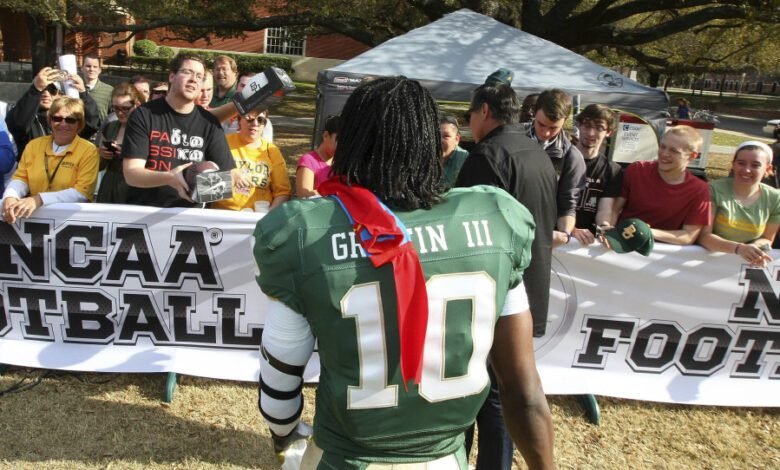EA Sports’ immersive college football returns

In a Michigan basement decorated with maize and blue, a father sat with his son.
They would come together over a football video game. One with a story mode that would transport the 7-year-old to a college dorm room, where fan mail filled his mailbox, the campus newspaper announced a championship, and a list of Heisman candidates adorned his computer screen. If he played well enough, his name might even appear there.
It wasn’t real. But who could say it couldn’t be?
“You know, we always joked, because he was a big kid, that ‘Hey, maybe you’ll be there someday,’” says his father, Bill Swartout.
Today, more than a decade later, that 7-year-old boy – Brayden Swartout – is an offensive lineman at Central Michigan, living story mode in real life.
Countless versions of this game, which haven’t been made in over a decade, gather dust in basements next to decommissioned game systems. It is the inevitable fate of old records, game cartridges, RCA connector wires and the like. But give it all a good jab and the dust will settle to reveal an enduring cultural phenomenon that, in this modern world, is making a comeback.
More than just a game
For a generation of young people, EA Sports’ college football games fueled their sports aspirations. From the first versions in the 1990s to the immersive experiences in the 2000s that revolutionized single-player creation, the games have become must-haves for sports and video game fans.
As they became more popular, however, something else grew as well: the chorus of voices saying that the college athletes portrayed in the game should be paid. It was a notion that seemed absurd in the era of the student-athlete. But as opinions changed, it started to make sense.
Before 2021, the NCAA did not allow college athletes to profit from their brand, commonly known as name, image and likeness – or NIL.
The video game developer has tried for years to differentiate in-game rosters from real-life players. “Quarterback No. 10” remembers this clearly.
“I remember when I was at the game. Obviously, in high school and everything, you want to be in the game, but when you get to college, you’re in the game, and I’m number 10 out of Baylor, before the NIL, and I’m number 10,” Robert Griffin III , one of the game’s 2013 cover athletes and 2011 Heisman winner, told the Associated Press.
“And that’s my name, ‘Baylor’s No. 10 Quarterback,’” he says. “But I’m white, faded cut and sleeveless and I’m from Tuscaloosa, Alabama. They tried to completely change the character just so they didn’t have to pay the guy. Or say, ‘Oh no, that’s not his name, image and likeness, he’s not even the right color.’ But everyone knew who No. 10 was at Baylor.”
Eventually, EA Sports backed out. And so the franchise remained after its last version in 2013, inactive for 11 years.
It’s back, for real this time
Society has changed a lot since the 2010s. So has Swartout’s basement, now decorated in brown and gold.
Gamers’ voracious appetite for immersive sports video games hasn’t changed all that much. And with the NCAA’s decision to allow college athletes to profit from their brand, the time has come.
EA Sports in 2021 announced that it would revive the franchise. Three years later, the game is set to release this summer, with a full reveal promised in May. Details have been few so far, but the names and images of the players will be real.
“I personally believe NCAA football is the greatest game ever made,” Griffin says. “A lot of kids who grew up with the game wanted to be able to see themselves grow and develop into the players they were raising.”
EA Sports offered Football Bowl Subdivision players a minimum of $600 and a copy of EA Sports College Football 25 to be included in the game. More than 10,000 players accepted.
The game will seek to differentiate itself from other offers on the market — sports franchises that have had the advantage of time to evolve. There is one difference: none of them faced college football.
“Video games, as popular as they were, evolved greatly based on the evolution of society and the existence of so many different modes and options,” said Nicolette Aduama, senior associate director of the Center for the Study of Sport at Northeastern University. in society.
Out with the old man
EA’s 2006 college football game was monumental in the world of sports video games. It was the first to completely involve players in an athlete’s life. It had a killer soundtrack. Perhaps their only rival in story mode in the early 2000s was the NBA Ballers.
It was also problematic, including a feature that doesn’t stand the test of time well. In a player creator’s dorm, hanging in the corner of the computer screen was a wallet-sized photo depicting a woman. As the player performed better on the field, the representation passed through the presets. A woman’s body type sometimes became thinner; her bust, hair color and smile have changed.
“I remember seeing this when I was a kid and even then I thought, ‘Why is your girlfriend more attractive if you win more games?’” says Eli Mouser, 21, of Russellville, Alabama. it makes no sense.”
EA Sports dropped this feature in later editions. He added another that had players choose a major and keep their GPA high to compete on the field. The developer has advanced its equity through other games, such as its professional football franchise, which now includes female players, and its newest golf game, which asks players for their pronouns when they create players.
“Girls also play,” said Aduama. “We see it in movies and TV shows where people are breaking these stereotypes and we talk about it in our training all the time. It’s a question of exposure.”
EA Sports says it is offering female athletes opportunities to get involved with the game through its ambassador program, which pays athletes to promote it.
“I know one game right now that would definitely blow up, and that would be women’s college basketball,” Griffin said. “Caitlin Clark on the cover. You have all the girls there with Angel Reese at LSU. Like, that game would wipe the floor.”
Given the game’s ambitious features, it’s easy to ask: When the new version comes out, which tweens will play it, find inspiration, and end up on a college football field a decade from now? What dreams of 2024 – embodied in what is sure to be the most immersive iteration of the game ever – will propel pathways to athletic success and realize tomorrow’s aspirations in high resolution?
For Mouser, growing up in Alabama as a Tennessee fan was difficult. EA Sports’ college football games gave him room to let out some of that orange in a sea of red. Just like Bill and Brayden Swartout, the game also gave him a chance to bond with his father.




